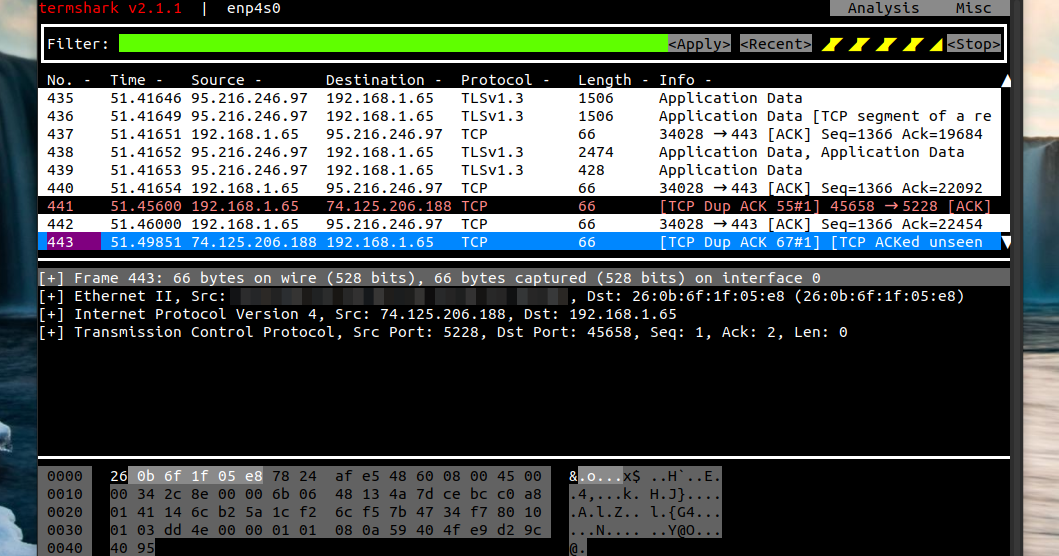

Wireshark How to Capture Packets From a Specific IP Address

You’ll see both the requests and the replies to the ping in the packets list.
Create a filter for ping packets by typing “icmp” in your display filter bar, then hit Enter. Go back to Wireshark and stop the capture process. Open your command prompt and ping the address of your choice.  Open Wireshark and start the capturing process as described above. The best way to capture ping packets (otherwise known as Internet Control Message Protocol (ICMP) Echo traffic) in Wireshark is by using a display filter in capture mode. You’ll have to enter “udp.port = 68” in the display filter bar. However, remember that display filters use a different syntax than capture filters. Similarly, a display filter can filter out DHCP packets in your capture screen. Use the capture filter “port 67” or “port 68” or the combination of the two “port 67 or port 68” to capture DHCP packets. To capture DHCP packets exclusively, you’ll need to enter the corresponding port number in the capture filter. The filter bar will be at the bottom of the Capture Interface. Tip: Another way to adjust your capture filters is clicking “Capture,” then “Options” in the menu. You can also add a specific port after “udp” if you wish to specify your filter further. Enter “udp” in the Capture Filter bar and press Enter to start capturing UDP traffic. It’s the one directly above your network list. Look for the Capture Filter bar on the welcome screen. If you want to capture UDP traffic only, use a capture filter before beginning the capturing process. The two filters work differently and use different commands, so you’ll need to decide which one best fits your needs. Display filters merely filter through already captured packets. Using a capture filter will mean the program only captures the packets you define. Wireshark supports both capture and display filters. If you’re only looking for information about certain packets, you can use filters to make your job easier. While different types of traffic are easily distinguishable in Wireshark thanks to color coding, you’ll still need to sift through a lot of data. How to Capture UDP Packetsįollowing the steps above will prompt the program to capture all packets. Start analyzing the data right away or save it for later by clicking “File” and then “Save As…” in the menu bar. Once satisfied with the amount of data gathered, you can stop capturing by clicking the red stop button in the top toolbar. You’ll see Wireshark grabbing data packets in real time. As soon as you click the network interface or the start button, you’ll be taken to the capture screen.
Open Wireshark and start the capturing process as described above. The best way to capture ping packets (otherwise known as Internet Control Message Protocol (ICMP) Echo traffic) in Wireshark is by using a display filter in capture mode. You’ll have to enter “udp.port = 68” in the display filter bar. However, remember that display filters use a different syntax than capture filters. Similarly, a display filter can filter out DHCP packets in your capture screen. Use the capture filter “port 67” or “port 68” or the combination of the two “port 67 or port 68” to capture DHCP packets. To capture DHCP packets exclusively, you’ll need to enter the corresponding port number in the capture filter. The filter bar will be at the bottom of the Capture Interface. Tip: Another way to adjust your capture filters is clicking “Capture,” then “Options” in the menu. You can also add a specific port after “udp” if you wish to specify your filter further. Enter “udp” in the Capture Filter bar and press Enter to start capturing UDP traffic. It’s the one directly above your network list. Look for the Capture Filter bar on the welcome screen. If you want to capture UDP traffic only, use a capture filter before beginning the capturing process. The two filters work differently and use different commands, so you’ll need to decide which one best fits your needs. Display filters merely filter through already captured packets. Using a capture filter will mean the program only captures the packets you define. Wireshark supports both capture and display filters. If you’re only looking for information about certain packets, you can use filters to make your job easier. While different types of traffic are easily distinguishable in Wireshark thanks to color coding, you’ll still need to sift through a lot of data. How to Capture UDP Packetsįollowing the steps above will prompt the program to capture all packets. Start analyzing the data right away or save it for later by clicking “File” and then “Save As…” in the menu bar. Once satisfied with the amount of data gathered, you can stop capturing by clicking the red stop button in the top toolbar. You’ll see Wireshark grabbing data packets in real time. As soon as you click the network interface or the start button, you’ll be taken to the capture screen.










